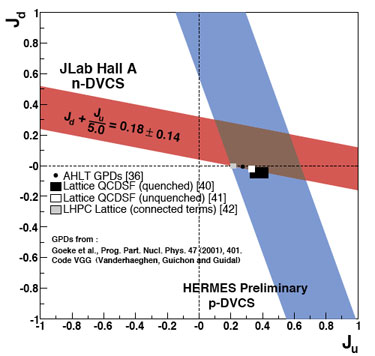NEWPORT NEWS, Va. - Puzzling out the source of proton and neutron spin is part of the ongoing experimental effort at Jefferson Lab to understand their structure and the structure of the nucleus of the atom.
Since the proton spin crisis, scientists have learned that a proton's spin comes not only from the spin of its quarks, but also from how the quarks move inside the proton, the quarks' so-called orbital angular momentum. Orbital angular momentum can be simply pictured as the movement of a top across a table as it spins. A small amount of the proton's spin is also expected from the force that glues the quarks together.

Data from the experiment on the neutron, denoted by the red bar, is in agreement with theoretical calculations, denoted by the small blocks. Complementary data from a similar experiment on the proton from the HERMES experiment at DESY in Germany is denoted by the blue bar.
A recent experiment in Jefferson Lab's Hall A set out to determine whether it's possible to measure the orbital angular momentum of the quarks inside the neutron. Malek Mazouz, who completed his doctorate on this experiment at the Laboratoire de Physique Subatomique et de Cosmologie (LPSC) in Grenoble, France, says to explore the source of the proton's spin, scientists must also determine the spin of the neutron. "Physicists treat the proton and the neutron as a manifestation of the same object, called the nucleon. If we want to understand deeply the structure of the proton, we need to perform experiments on the neutron and not only the proton."
The experiment was led by physicists from the LPSC, the Laboratoire de Physique Corpusculaire (LPC) in Clermont-Ferrand, France, the Commissariat l'Energie Atomique (CEA), France, Old Dominion University In Norfolk, Va., and Jefferson Lab.
The measurements were thought possible due to theory advancements since the proton spin crisis, particularly the development of mathematical functions called generalized parton distributions (GPDs). "They offer the exciting possibility to 'see' a three-dimensional picture of the nucleon," Mazouz says. "GPDs allow, for the first time, a means to determine the quark orbital momentum."
In the experiment, a beam of electrons was sent into targets of hydrogen and deuterium. The scientists were particularly interested in electrons that tapped a quark inside a neutron. The tap gives the quark extra energy, which it must release in order for it to be reconstituted in the nucleon. The released energy, in the form of a photon, was measured in experimental detectors designed for that purpose.
"GPDs represent the probability to remove a quark with a given momentum (and spin direction) from the nucleon, then to restore it with a different momentum (and spin)," Mazouz explains. With enough experimental data on GPDs, the theory predicts that it will be possible to determine the distribution of quark orbital angular momentum inside the nucleon.
For this part of the experiment, Mazouz says the scientists weren't expecting to measure a particular value for a quark's orbital angular momentum. "Demonstrating that we could do this type of measurement was as important as getting a number for the quark's orbital angular momentum."
They found that they could, indeed, get enough information from experimental data to begin the task of extracting information about quarks' orbital angular momentum. The result appeared in the December 14 issue of the journal Physical Review Letters.
Mazouz is co-spokesperson of a new proposal by the collaboration to continue this research with more detailed measurements. "With the planned upgrade of Jefferson Lab to 12 GeV, systematic studies will shed new light on nucleon structure and may bring a definitive answer to the exciting mystery of the nucleon spin."
Technical Paper:
Deeply Virtual Compton Scattering off the Neutron
M. Mazouz et al. (Jefferson Lab Hall A Collaboration)
Further Reading:
Big Experimental Equipment: Hall A's DVCS@JLab

